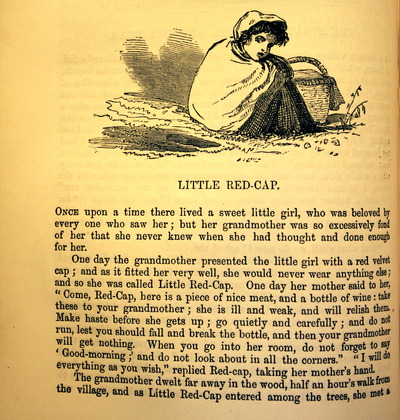Little Red Riding Hood
The Grimms’ first edition of Children’s and Household Tales, published in two volumes in 1812 and 1815, was intended to be a reference text for those interested in researching German folk-tales. It became rapidly apparent, however, that the potential for commercial success lay in the children’s literature market opposed to the scholastic. Subsequent editions and translations of the text moved increasingly away from the Grimms’ initial focus of preserving oral folk-tales in their original form, and the stories were comprehensively edited and censored to make them suitable for childish, and parental, consumption.
The version of ‘Little Red Cap’ included in this 1865 translation of a later edition of the Grimms’ Household Stories is an example of the Victorian influence on what was once an explicit folk-tale for adult consumption. References to sex and sexual impropriety, and the seduction element implied in Perrault’s version, have been all but eliminated; instead Little Red Cap is the epitome of the Victorian child, and her family unit takes on the role of moral compass that is absent in Perrault. Little Red Cap’s mother offers words of caution, advising her against improper haste- ‘do not run, lest you should fall and break the bottle’; ill manners- ‘do not forget to say “Good-Morning”’; and the perils of idle curiosity- ‘do not look about in all the corners’. These are admonishments concerning appropriate social comportment opposed to counsels against the dangers of sexual urges, and the emphasis on Victorian etiquette is apparent. Yet an alternative reading of the maternal concern allows for an implied warning about sexual impropriety; the bottle that Little Red Cap could break may represent her virginity, lost in her undue haste to mature sexually, resulting in a ‘fall’ from grace. The dark, hidden ‘corners’ her mother urges her to avoid are those aspects of adulthood she should be wary to confront, and Little Red Cap is thus urged to maintain the childish innocence easily sullied by curiosity.
Whether this dual aspect of the tale was intended by the authors is unknown, yet when compared to earlier versions, this Victorian rendition of the tale is notably devoid of overt sexual references: Little Red Cap does not disrobe for the wolf, nor does she join him in her grandmother’s bed. The focus on the family unit’s responsibility for moral guidance is perpetuated further by the hunter who kills the wolf at the end of the tale, thus fulfiling the patriarchal role of eliminating the predator and the threat it poses, although he is ultimately too late to save Little Red Cap. By identifying the wolf as the ‘old sinner’, perhaps the devil himself sent to lead young girls astray, he represents the moral and physical protection personified by the nineteenth century male figure of husband or father. The maternal and paternal elements in the tale therefore operate as a framing device which provides the moral impetus of the tale: discipline and the primacy of the father are the constitutive elements of the Victorian childhood experience, and failure to adhere to this framework result in dire consequences.
The Grimms’ ‘Little Red Cap’ thus promotes female obedience to the patriarchal order imposed by Victorian society, and yet the authors also provide an alternative ending which takes a far more feminist stance. Generally not included in the majority of editions of their Household Stories, this version allows scope for the female protagonists to take control of their own situation without the intervention of a male character. Together they outwit and ultimately eliminate a predator representing the most deviant and base of male sexual urges, indicated by its intention to ‘sneak after [Little Red Cap] and devour her in the darkness’; they are resilient and resourceful opposed to naïve and helpless, and the wolf is undermined by its own foolishness and greed. That it is killed by its lust for symbolically phallic foodstuffs such as sausages deserves some attention, but perhaps this reading stretches appropriate analogy to breaking point!




